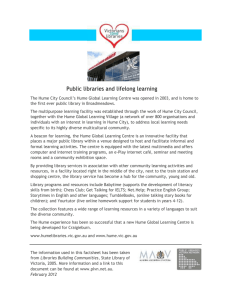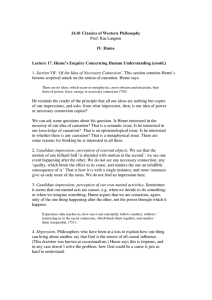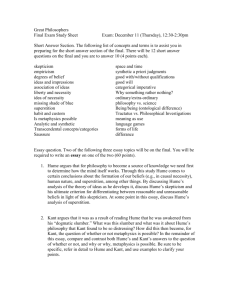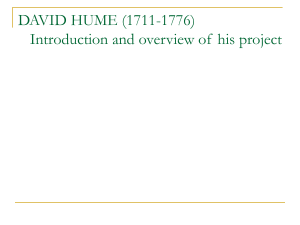“How Cantillon and Hume Propose the Same Theory of First-Round Effects”
advertisement
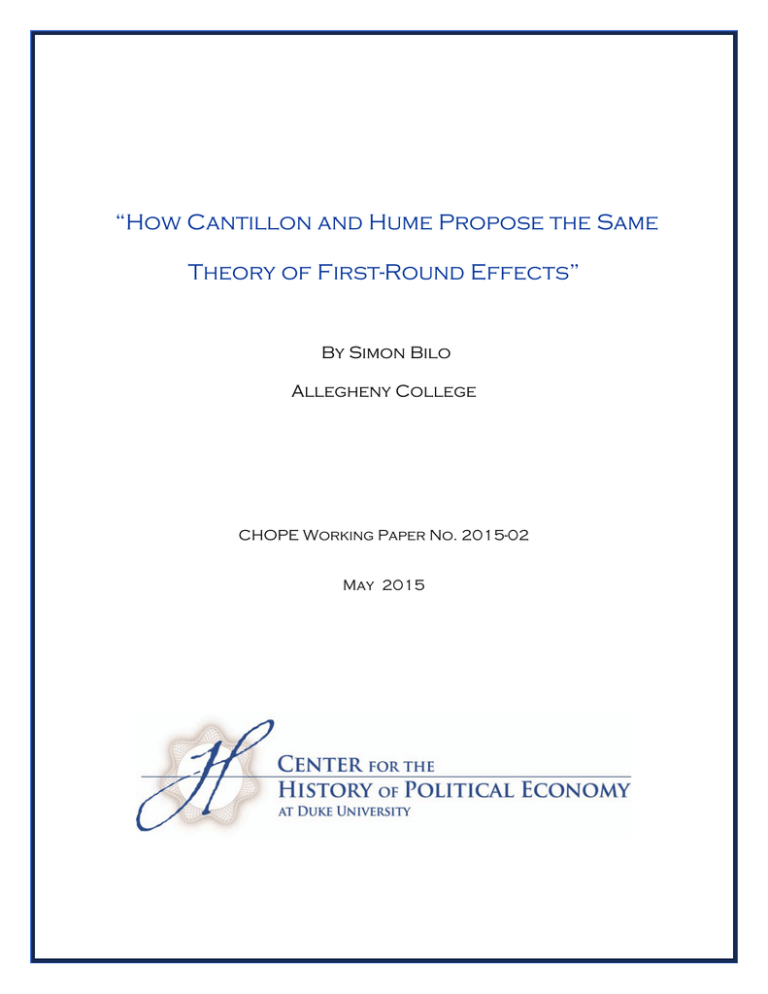
“How Cantillon and Hume Propose the Same Theory of First-Round Effects” By Simon Bilo Allegheny College CHOPE Working Paper No. 2015-02 May 2015 How Cantillon and Hume Propose the Same Theory of First-Round Effects* Simon Bilo† ABSTRACT Richard Cantillon and David Hume both propose the theory of monetary nonneutrality, whereby the money supply changes through the money balances of specific individuals. Such an uneven distribution of monetary change then spreads throughout the economy step by step and changes relative prices. While a number of authors note that Hume and Cantillon both present the same theory, they do so without seeking confirmation from the original texts. I fill this gap in the literature by identifying the main constituent parts of the theory in the contributions of both Cantillon and Hume. Keywords: Cantillon, Cantillon effects, first-round effects, Hume, injection effects JEL classification: B11, B31, E51 * † I would like to thank to Harry David for valuable comments and suggestions to the earlier drafts of the present paper. I gratefully acknowledge the financial help that I received from the Bradley Foundation, the Center for the History of Political Economy at Duke University, the Earhart Foundation, the Institute for Humane Studies, and the Mercatus Center while working on this project. I am responsible for all errors. Assistant Professor, Economics Department, Allegheny College, 520 North Main Street, Meadville, PA 16335; Email: sbilo@allegheny.edu. How Cantillon and Hume Propose the Same Theory of First-Round Effects Introduction Richard Cantillon and David Hume are among the most important economists writing prior to The Wealth of Nations.1 I focus on the small segment of their contributions pertaining to how the money supply affects relative prices, so-called “first-round effects” (Cairnes 1873, Friedman 1972). A number of authors recognize that both Cantillon and Hume present the theory of first-round effects, also known as “Cantillon effects” or “injection effects.”2 No one, however, provides supporting textual evidence from the writings of the two. And Spengler's (1954a: 283) claim that Hume's contribution did not include “Cantillon's brilliant analysis … of the response of the price structure to changes in the quantity of money” has not been refuted. If Spengler is correct, Hume’s treatment of the subject differs from Cantillon's. My goal is to fill the gap in the literature by using textual evidence to refute Spengler's statement. Whether both Cantillon (2010 [1755]) and Hume (1826ab [1752]) propose the theory of first-round effects is also important for the question of whether Cantillon and Hume wrote the theory independently of each other. This question 1 2 For general discussions of Cantillon's contributions, see, e.g., Hayek (1985 [1931]), Murphy (1987), and Spengler (1954ab). Bordo (1983) gives an overview of Cantillon's monetary economics. Henderson (2010), McGee (1989), and Schabas and Wennerlind (2011) give general overviews of Hume's economics; Duke (1979) and Paganelli (2006; 2009), e.g., discuss his monetary economics. Blaug (1991: ix; 1999: 21), Cesarano (1983: 199), Hayek (1985 [1931]: 220, 238-9; 1967 [1935]: 9-10), Henderson (2010: 164), Horwitz (2003: 80 ff., 92 n11), Humphrey (1974: 5-6), Marget (1966a [1938-1942]: 501-2; 1966b [1938-1942]: 309), Monroe (2001 [1923]: 149), Perlman (1987: 11), Spiegel (1971: 213), and Thornton (2007: 461). 2 arises because while the official publication date of Hume's work is earlier, Cantillon's (2010 [1755]) Essay was written earlier and circulated as an unpublished manuscript since the 1730s (Thornton 2007: 454). That Cantillon preceded Hume has thus led scholars to speculate on whether Hume was aware of Cantillon's manuscript while working on his own monetary writings. Blaug (1991: ix) accuses Hume of plagiarism, although he later takes back that claim (Thornton 2007: 462 n10). Hayek notes that by looking at the monetary writings of the two “one gets the inescapable impression that Hume must in fact have known Cantillon” (1985 [1931]: 238; also 1967 [1935]: 9). Rothbard (2006 [1995]: 360) makes a similar suggestion along more general lines, and Thornton (2007) provides contextual historical evidence that Hume could have known Cantillon's writings. While conclusive evidence does not exist, as Brewer (1992: 186), Henderson (2010: 163–166), Monroe (2001 [1923]: 211, n658), Perlman (1987: 283–284, n5), van den Berg (2012: 49–52), and Viner (1937: 74 n2) all point out, careful textual comparison of the arguments of Cantillon and Hume reveals similarities or differences between the two authors and thereby gives additional indirect evidence on whether Cantillon influenced Hume. The following analysis therefore contributes to the existing literature on the relationship between Cantillon and Hume in two ways. First, while there is broad consensus that Hume and Cantillon both present the idea of first-round effects, scholars have not supported this claim with textual evidence, which makes it hard to refute claims to the contrary, such as Spengler's (1954a). I provide the 3 evidence, and by doing so, I support the thesis that Hume could have been inspired by Cantillon's Essay in his monetary writings. II. Cantillon and Hume on First-Round Effects To compare Cantillon's and Hume's writings on the theory of first-round effects, I look at each of the authors separately. I identify the following three constituent parts of the theory. First, changes in the money supply happen through the money balances of specific individuals. Second, the people whose money balances change respond by adjusting expenditures. As every such adjustment affects the money balances and expenditures of other people, the initial change progresses throughout the economy step by step. And third, the progression of changing expenditures also affects people’s demand for goods and their relative prices. I identify each of these constituent parts in both Cantillon's and Hume's writings and thereby show that they present the same theory of first-round effects. II.1 Cantillon on First-Round Effects Cantillon discusses the consequences of monetary change in chapters 6 and 7 of the second volume of his Essay (2010 [1755]: 147–157). The discussion includes all of the three constituent parts of the theory of first-round effects. First, Cantillon highlights the importance of the point from which the money supply changes. For example, an increase in the money supply arises 4 through the actions of particular individuals, such as owners of gold or silver mines (ibid.: 147, 148, 155), those initially affected by the balance of foreign trade (ibid: 150), or foreign travelers and wealthy immigrants (ibid.: 152, 156). When he discusses an increase in the money supply through expenditures of “ambassadors and foreign travelers residing in England,” the number of the initial recipients of the new money is limited, as this money will pass first into the hands of various artisans, servants, entrepreneurs and others who have had a share in providing transportation, amusements, etc., for these foreigners. (Cantillon 2010 [1755]: 156) The emphasis that Cantillon puts on the sources of monetary change then allows him to talk about the second constituent part of the theory of first-round effects, the step-by-step progression of money-induced change throughout the economy. This progression starts with people affected by the monetary change first, who for that reason adjust their expenditures. The adjustment spills over to the money balances and expenditures of people who engage in commerce with the people initially affected. The impact of the monetary change then spreads further across the economy, repeating through the same mechanism: once the change has an impact on one's money balance, it affects his expenditures and thereby affects the money balances of his commercial partners. Cantillon in this 5 regard talks about a situation where owners of gold and silver mines spend their additional money balances on the services of artisans. If the increase of hard money comes from gold and silver mines within the state, the owner of these mines, the entrepreneurs, the smelters, refiners, and all the other workers will increase their expenses in proportion to their profits. Their households will consume more meat, wine, or beer than before. They will become accustomed to wearing better clothes, having finer linens, and to having more ornate houses and other desirable goods. Consequently, they will give employment to several artisans who did not have that much work before and who, for the same reason, will increase their expenditures. (Cantillon 2010 [1755]: 148– 149, see also 156). Cantillon uses the previous two insights about monetary change to formulate the final constituent part of the theory of first-round effects. As the change in the quantity of money arises through the money balances of particular individuals and spreads through the economy step by step, it changes the relative prices of goods. Cantillon therefore concludes that 6 an increase of actual money in a state always causes an increase of consumption and a routine of greater expenditures. But the higher prices caused by this money does [sic] not affect all commodities and merchandise equally. Prices do not rise proportionally to the quantity of money, unless what has been added continues in the same circulation channels as before. In other words, those who offered one ounce of silver in the market would be the same and only ones to offer two ounces when the amount of money in circulation is doubled, and that is hardly ever the case. I recognize that when a large surplus of money is introduced in a state, the new money gives a new direction to consumption, and even a new speed to circulation. However, it is not possible to say exactly to what extent. (Cantillon 2010 [1755]: 157).3 One can therefore conclude that Cantillon's discussion of the non- 3 Cantillon makes a similar statement earlier on: The change in relative prices, introduced by the increased quantity of money in the state, will depend on how this money is directed at consumption and circulation. No matter who obtains the new money, it will naturally increase consumption. However, this consumption will be greater or less, according to circumstances. It will more or less be directed to certain kinds of commodities or merchandise, according to the judgment of those who acquire the money. Market prices will increase more for certain goods than for others, however abundant the money may be. (Cantillon 2010 [1755]: 156) 7 neutrality of money ties together all three constituent parts of the theory of firstround effects. He identifies different potential origins of monetary change; he recognizes the step-by-step sequence through which monetary change spreads through the economy; and he concludes that such a change in the money supply affects relative prices. II.2 Hume on First-Round Effects I now turn to Hume's two main contributions to the topic of monetary nonneutrality, his Of Money (1826a [1752]) and Of Interest (1826b [1752]). Hume follows in these contributions the three constituent parts of the theory of firstround effects I noted above. He is therefore consistent with Cantillon's approach. First, Hume assumes that changes in the money supply originate through the money balances of specific people. He makes this assumption while discussing what happens when a nation appropriates money through conquest of foreign lands (1826b [1752]: 345), and he discusses it generally for when people import money: When any quantity of money is imported into a nation, it is not at first dispersed into many hands; but is confined to the coffers of a few persons, who immediately seek to employ it to advantage. (Hume 1826a [1752]: 322–323) 8 Second, Hume describes the step-by-step sequence in which a change in the money supply progresses throughout the economy. He raises the topic of monetary change, for example, when talking about merchants importing new money into the country (1826a [1752]: 323). He also provides a more general statement when he says that some time is required before the [new] money circulates through the whole state, and makes its effect be felt on all ranks of people[.] (Hume 1826a [1752]: 322) And third, Hume’s assumptions about how the money supply changes and how it spreads throughout the economy lead Hume to formulate the last constituent part of the theory of first-round effects. Following the same reasoning as Cantillon, Hume argues that changes in the quantity of money lead to changes in relative prices. He describes such relative price changes in the contexts of importing new money (1826a [1752]: 323), decreasing the quantity of money (1826a [1752]: 325), or increasing the quantity of money after foreign conquests (1826b [1752]: 345). In his general discussion of an increase in the quantity of money, Hume then comments that though the high price of commodities … [is] a necessary consequence of the encrease of gold and 9 silver, yet it follows not immediately upon that encrease; but some time is required before the money circulates through the whole state, and makes its effect be felt on all ranks of people. At first, no alteration is perceived; by degrees the price rises, first of one commodity, then of another; till the whole at last reaches a just proportion with the new quantity of specie which is in the kingdom. (Hume 1826a [1752]: 322) Hume's discussion of change in the money supply and its effects on relative prices therefore matches that of Cantillon. It follows Cantillon in all three constituent parts of the theory of first-round effects, which means that the two authors propose the same theory. Conclusion Comparing Cantillon and Hume’s texts on first-round effects supports the claims that the arguments of the two are in this regard identical and implies that Spengler's (1954a:) suggestion to the contrary is incorrect. We know that Hume and Cantillon propose the same theory because they build their arguments from the same three constituent parts. First, money changes originate through the money balances of a specific group of people. Second, it takes time before the 10 monetary change spreads across the money balances of all individuals in the economy. And third, the diffusion of monetary change is accompanied by changes in the relative prices of goods. The analysis above does not provide definitive evidence on whether Hume read Cantillon before working on his essays. However, that Hume and Cantillon propose the same theory means that one cannot reject this hypothesis. 11 References Blaug, Mark, ed. (1991). Richard Cantillon (1680–1734) and Jacques Turgot (1727–1781). Brookfield, VT: Edward Elgar Publishing. Blaug, Mark (1999). Economic Theory in Retrospect. New York: Cambridge University Press. Bordo, Michael David (1983). “Some Aspects of the Monetary Economics of Richard Cantillon.” Journal of Monetary Economics 12, 235–258. Brewer, Anthony (1992). Richard Cantillon: Pioneer of Economic Theory. New York: Routledge. Cairnes, John E. (1873). Essays in Political Economy: Theoretical and Applied. London: Macmillan and Co. Cantillon, Richard (2010 [1755]). An Essay on Economic Theory. Auburn, Alabama: Ludwig von Mises Institute. Cesarano, Filippo (1983). “The Rational Expectations Hypothesis in Retrospect.” American Economic Review 73, 198–203. 12 Duke, Michael I. (1979). “David Hume and Monetary Adjustment.” History of Political Economy 11, 572–587. Friedman, Milton (1972). “The John R. Commons Lecture: Monetary Trends in the United States and the United Kingdom.” American Economist 16, 4–17. Hayek, Friedrich August von (1985 [1931]). “Richard Cantillon.” Journal of Libertarian Studies 7, 217–247. Hayek, Friedrich August von (1985 [1931]). “Richard Cantillon.” Journal of Libertarian Studies 7, 217–247. Henderson, Willie (2010). The Origins of David Hume's Economics. New York: Routledge. Horwitz, Steven (2003). “The Costs of Inflation Revisited.” Review of Austrian Economics 16, 77–95. Hume, David (1826b [1752]). “Of Interest.” In David Hume (1828). The Philosophical Works of David Hume, vol. 3 (Essays Moral, Political, and Literary). Edinburgh: Adam Black and William Tait; and Charles Tait, 333–347. 13 Hume, David (1826a [1752]). “Of Money.” In David Hume (1828). The Philosophical Works of David Hume, vol. 3 (Essays Moral, Political, and Literary). Edinburgh: Adam Black and William Tait; and Charles Tait, 317–332. Humphrey, Thomas M. (1974). “The Quantity Theory of Money: Its Historical Evolution and Role in Policy Debates.” FRB Richmond Economic Review 60, 2– 19. Marget, Arthur W. (1966a [1938–1942]). The Theory of Prices: A Re-Examination of the Central Problems of Monetary Theory, Volume I. New York: Augustus M. Kelley. Marget, Arthur W. (1966b [1938–1942]). The Theory of Prices: A Re-Examination of the Central Problems of Monetary Theory, Volume II. New York: Augustus M. Kelley. McGee, Robert W. (1989). “The Economic Thought of David Hume.” Hume Studies 15, 184–204. Monroe, Athur Eli (2001 [1923]). Monetary Theory Before Adam Smith. Kitchener, Ontario: Batoche Books. 14 Murphy, Antoin E. (1987). Richard Cantillon: Entrepreneur and Economist. New York: Oxford University Press. Paganelli, Maria Pia (2006). “Hume and Endogenous Money.” Eastern Economic Journal 32, 533–547. Paganelli, Maria Pia (2009). “David Hume on Monetary Policy: A Retrospective Approach.” Journal of Scottish Philosophy 7, 65–85. Perlman, Morris (1987). “Of a Controversial Passage in Hume.” Journal of Political Economy 95, 274–289. Rothbard, Murray N. (2006 [1995]). Economic Thought before Adam Smith: An Austrian Perspective on the History of Economic Thought, Volume I. Auburn, Alabama: Ludwig von Mises Institute. Schabas, Margaret, and Carl Wennerlind (2011). “Hume on Money, Commerce, and the Science of Economics.” Journal of Economic Perspectives 25, 217–230. Spengler, Joseph J. (1954a). “Richard Cantillon: First of the Moderns. I.” Journal of Political Economy 62, 281–295. 15 Spengler, Joseph J. (1954b). “Richard Cantillon: First of the Moderns. II.” Journal of Political Economy 62, 406–424. Spiegel, Henry William (1973). The Growth of Economic Thought. Englewood Cliffs, NJ: Prentice-Hall. Thornton, Mark (2007). “Cantillon, Hume, and the Rise of Antimercantilism.” History of Political Economy 39, 453–480. van den Berg, Richard (2012). “Richard Cantillon’s Early Monetary Views?” Economic Thought 1, 48–79. Viner, Jacob (1937). Studies in the Theory of International Trade. New York: Harper and Brothers. 16
